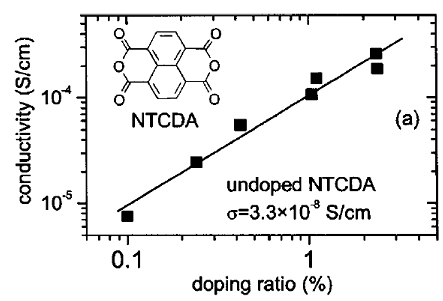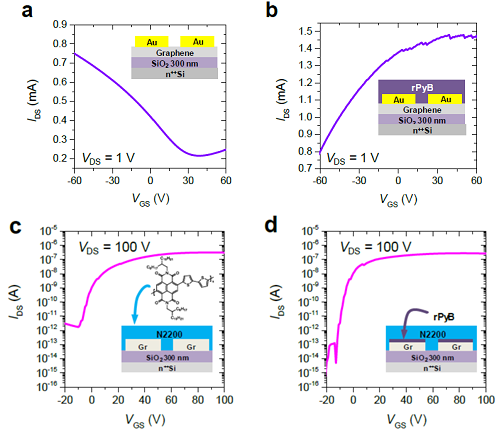eISSN: 2574-9927


Mini Review Volume 4 Issue 4
RIPE & 3D Printing, Hanbat National University, Republic of Korea
Correspondence:
Received: June 30, 2020 | Published: July 17, 2020
Citation: Huseynova G. Mini-review: reduced pyronin B as an N-type dopant for organic electronics. Material Sci & Eng. 2020;4(4):98-100. DOI: 10.15406/mseij.2020.04.00134
The usage of organic dyes for organic electronics is expanding towards a wide range of applications and the results and experiences of the recent studies are being shared internationally. Due to specific features of some organic dyes, such as their ionic charge, they have received huge attention as dopants for organic materials. In this mini review, n-type doping properties of an organic salt, Pyronin B which is a well-known cationic dye, will be discussed. This dye has been demonstrated as a promising n-type dopant for organic conductors in its reduced state. In addition, Pyronin B is among relatively non-toxic and low-cost compounds. Furthermore, this molecule can also be solution-processed at room temperature which makes it extremely suitable for low cost and flexible electronic devices.
Keywords: organic electronics, organic semiconductors, organic dopants, cationic dyes, pyronin B, n-doping, n-dopants, reduced dopants
Organic electronics which uses organic materials as an active part of the devices has become an unsplit segment of modern electronics. These organic materials are carbon-based small molecules or polymers. The main advantages of organic molecules are their flexibility, solution- and low-temperature-process ability as well as their bio-degradability.1–3 However, organic molecules suffer from poor electrical conductivity which severely limits their applications.4 Until 1970s, when the first highly conductive organic molecule of poly acetylene was obtained via doping, organic materials were mostly considered as effective electrical insulators applied to various fields of electronics.5 Since that time, organic electronics has thrived tremendously owing to the studies encouraging development of high-performance, low-cost, and flexible organic electronic devices to replace high-cost and rigid silicon-based inorganic electronic devices. Doping is among the most feasible methods to improve the electrical properties of organic materials and has played a significant role for achieving the recent progress.6–8 Nevertheless, doping in organic electronics is considerably different from that in inorganic electronics. Unlike the dopants used in inorganic electronics, the dopants for organic materials do not replace atoms in host lattices in order to provide the host molecules with extra charges. These dopants simply increase the number of the charge carriers in the frontier molecular orbitals of the host molecules by donating or accepting corresponding charges.9 Notwithstanding the fact that p-type doping of organic materials has advanced very far, n-type doping still faces serious challenges due to the deficiency and instability of the existing n-type dopants.10,11 However, n-type doping of organic semiconductors using reduced cationic species have been proven to be an effective method to improve electrical performance of these materials.12–15 In this mini-review, the research conducted on n-type doping effects of the reduced molecule of a cationic dye, Pyronin B, will be summarized and discussed. The main focus of the discussions will be the studies of AG Werner et al14 & EK Lee et al.15
The doping approach presented in Ref. 14 suggests thermal co-evaporation of cationic species such as Pyronin B, with host molecules for n-type doping. In this case, a stable cationic molecule of the dopant acts as a main precursor for the formation of an n-type doping agent. Here, the electrons existing in the highest occupied molecular orbital (HOMO) of the cationic molecule are excited by the incorporation of heat or light in order to provide them with enough energy to overcome the band gap and transfer to the lowest unoccupied molecular orbital (LUMO) of the same molecule. This way, the molecule becomes an unstable radical. This radical form of the cationic dyes is called leuco state which is colorless. In this state, the molecule of the dye is ready to donate the electron in its LUMO to the LUMO of another molecule it interacts with in order to recover its stable cationic state. Hence, after doping, the electrical conductivity of NTCDA increased up to four orders of magnitude compared to the pristine NTCDA. In addition, the activation energy of the material was decreased from 0.40 to 0.25eV. Figure 1 shows the results of this doping approach.

Figure 1 Conductivity of the reduced Pyronin B-doped NTCDA layers as a function of the doping concentration.14
The study performed in Ref. 15, suggests formation of an unstable neutral (radical) state of the same dye molecule via a simple solution-processed chemical reaction. The reaction involves reduction of the cationic Pyronin B by NaBH4 after which, the dye molecule loses its color and becomes colorless (leuco). In this state, this molecule acts as a strong electron donor when it interacts with other molecules. Therefore, the reduced Pyronin B was used as an effective solution-processed n-type dopant for flexible graphene applied to field-effect transistors as an electrode or active layer material. For this purpose, the solution of the reduced dye was simply spin-coated onto the graphene layer. As a result, the drain current of the transistors with graphene active layer was enhanced significantly as well as the work function of graphene electrodes was reduced from 4.52eV to 3.98eV which significantly enhanced the electron injection, transport, and stability of the fabricated n-type organic transistors. Figure 2 illustrates the results of this work.

Figure 2 Transfer curves of the fabricated transistors with graphene (A & B) and n-type polymer (C & D) active layer before (A & C) and after (B & D) the coating of the reduced PyB.15
In conclusion, an effective n-type doping characteristics of a cationic dye Pyronin B have been demonstrated. For this purpose, the cationic molecule has to be reduced to its colorless leuco state to form an unstable radical ion which easily donates its electrons to other molecules during an interaction. Furthermore, it has been demonstrated that this electron-donating state of this dye can be achieved by both solid-state (thermal evaporation) and solution-processed techniques. The conductivity and work function of the host molecules doped with the reduced Pyronin B were effectively modified for improved device performance.
None.
Authors declared that there is no conflict of interest.

©2020 Huseynova. This is an open access article distributed under the terms of the, which permits unrestricted use, distribution, and build upon your work non-commercially.